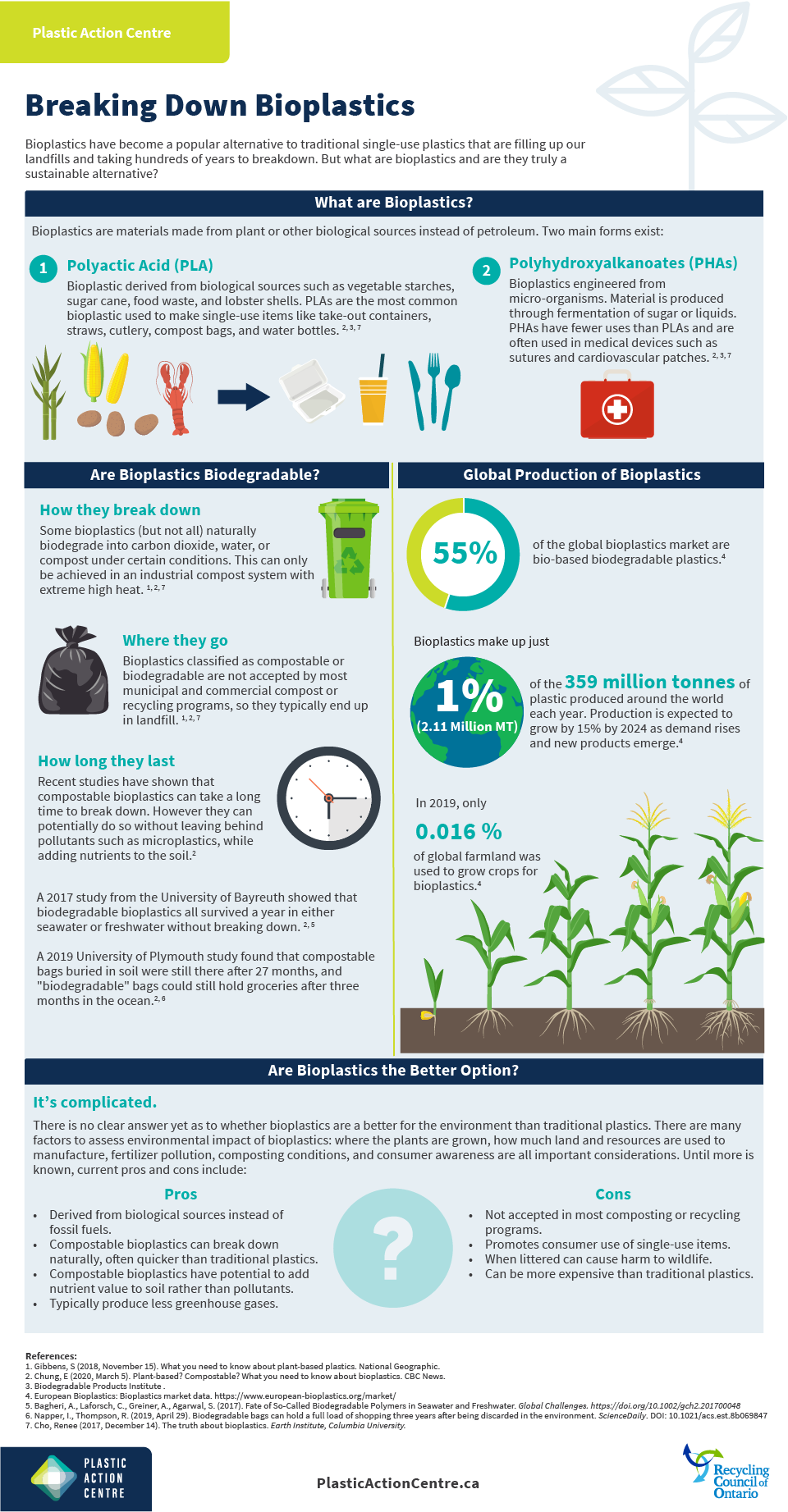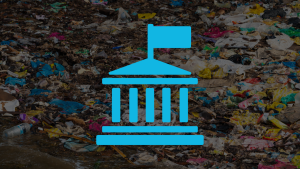- Recycling
- Standards and Certification
- Public Consultation
- Take Action
- National
Breaking Down Bioplastics
Bioplastics have become a popular alternative to traditional single-use plastics that are filling up our landfills and take hundreds of years to breakdown. But what are bioplastics and are they truly a sustainable alternative?

Text version of resource
What are Bioplastics?
Bioplastics are materials made from plant or other biological sources instead of petroleum. Two main forms exist:
- Polyactic Acid (PLA) Bioplastic derived from biological sources such as vegetable starches, sugar cane, food waste, and lobster shells. PLAs are the most common bioplastic used to make single-use items like take-out containers, straws, cutlery, compost bags, and water bottles.
- Polyhydroxyalkanoates (PHAs) Bioplastics engineered from micro-organisms. Material is produced through fermentation of sugar or liquids. PHAs have fewer uses than PLAs and are often used in medical devices such as sutures and cardiovascular patches.
Are Bioplastics Biodegradable?
How they break down
Some bioplastics (but not all) naturally biodegrade into carbon dioxide, water, or compost under certain conditions. This can only be achieved in an industrial compost system with extreme high heat.
Where they go
Bioplastics classified as compostable or biodegradable are not accepted by most municipal and commercial compost or recycling programs, so they typically end up in landfill.
How long they last
Recent studies have shown that compostable bioplastics can take a long time to break down. However they can potentially do so without leaving behind pollutants such as microplastics, while adding nutrients to the soil.
A 2017 study from the University of Bayreuth showed that biodegradable bioplastics all survived a year in either seawater or freshwater without breaking down.
A 2019 University of Plymouth study found that compostable bags buried in soil were still there after 27 months, and “biodegradable” bags could still hold groceries after three months in the ocean.
Global Production of Bioplastics
- 55% of the global bioplastics market are bio-based biodegradable plastics.
- Bioplastics make up just 1% (2.11 Million MT) of the 359 million tonnes of plastic produced around the world each year. Production is expected to grow by 15% by 2024 as demand rises and new products emerge.
- In 2019, only 0.016 % of global farmland was used to grow crops for bioplastics.
Are Bioplastics the Better Option?
It’s Complicated.
There is no clear answer yet as to whether bioplastics are a better for the environment than traditional plastics. There are many factors to assess environmental impact of bioplastics: where the plants are grown, how much land and resources are used to manufacture, fertilizer pollution, composting conditions, and consumer awareness are all important considerations. Until more is known, current pros and cons include:
Pros
- Derived from biological sources instead of fossil fuels.
- Compostable bioplastics can break down naturally, often quicker than traditional plastics.
- Compostable bioplastics have potential to add nutrient value to soil rather than pollutants.
- Typically produce less greenhouse gases.
Cons
- Not accepted in most composting or recycling programs.
- Promotes consumer use of single-use items.
- When littered can cause harm to wildlife.
- Can be more expensive than traditional plastics.
References
- Gibbens, S (2018, November 15). What you need to know about plant-based plastics. National Geographic.
- Chung, E (2020, March 5). Plant-based? Compostable? What you need to know about bioplastics. CBC News.
- Biodegradable Products Institute.
- European Bioplastics: Bioplastics market data.
- Bagheri, A., Laforsch, C., Greiner, A., Agarwal, S. (2017). Fate of So-Called Biodegradable Polymers in Seawater and Freshwater. Global Challenges. https://doi.org/10.1002/gch2.201700048.
- Napper, I., Thompson, R. (2019, April 29). Biodegradable bags can hold a full load of shopping three years after being discarded in the environment. ScienceDaily. DOI: 10.1021/acs.est.8b069847
- Cho, Renee (2017, December 14). The truth about bioplastics. Earth Institute, Columbia University.



